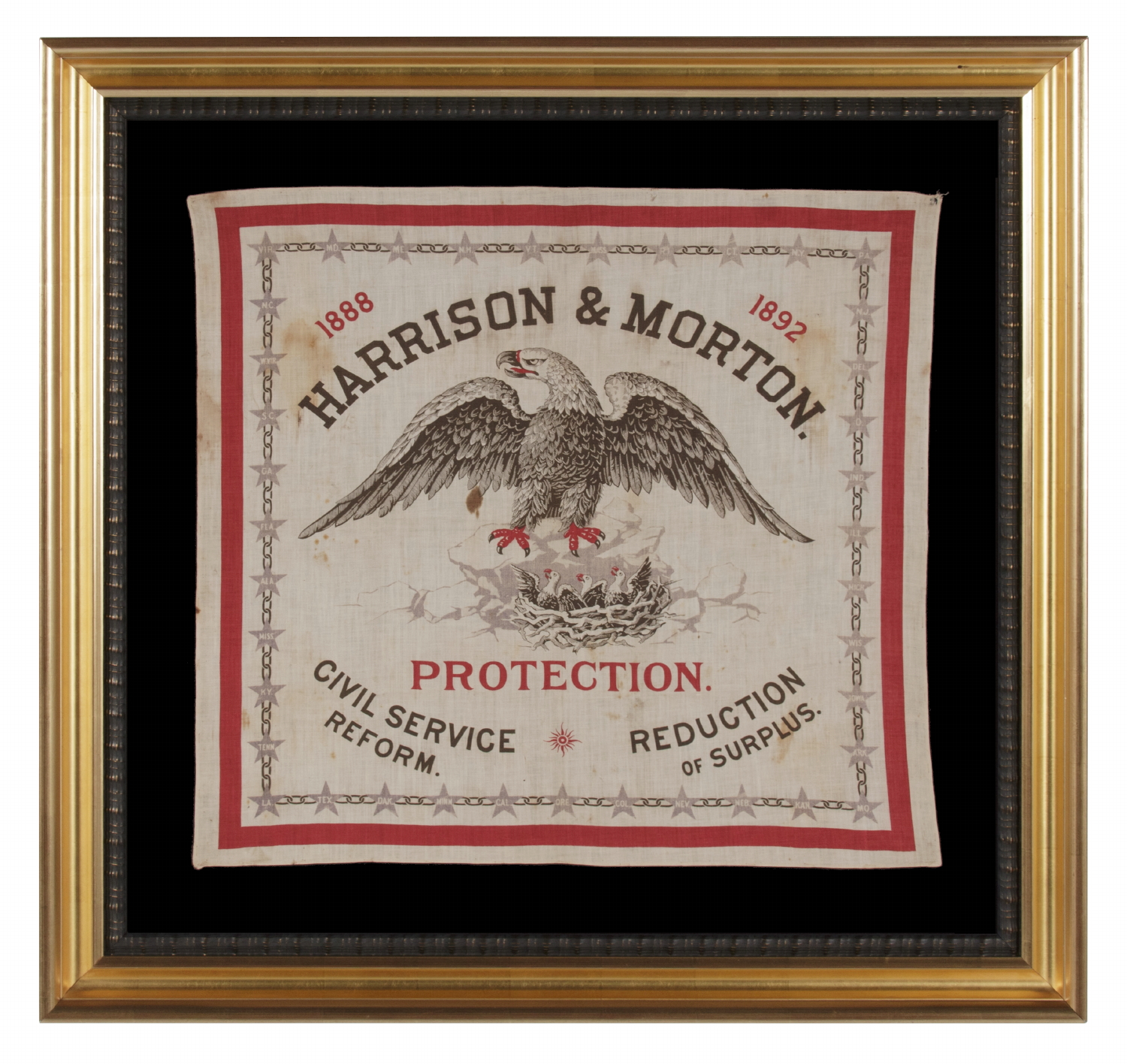
| |
RARE KERCHIEF MADE FOR THE 1888 CAMPAIGN OF REPUBLICAN BENJAMIN HARRISON, WITH THE IMAGES OF A BALD EAGLE ON A NEST WITH EAGLETS |
|
| Available: |
Sold |
| Frame Size (H x L): |
33.25" x 34.25" |
| Flag Size (H x L): |
23" x 24.75" |
|
| Description....: |
|
The style of this printed cotton kerchief, made for the 1888 presidential campaign of Benjamin Harrison & Levi Morton, is based upon a July 31, 1888 patent (No. 18,497) obtained by Rufus H. Rose of New York. One may argue that the graphics solicit one of the most striking illustrations of a political platform of all the textiles discussed thus far. The names of the candidates are arched above a fierce bald eagle, with her wings spread to protect a nest of three eaglets. In case the viewer does not get the metaphor, “PROTECTION” is printed in bright red letters below the scene. This slogan is repeated over and over on Harrison textiles, stating the Republican policy for high tariffs to protect American industry.
Two other tenets of the Republican platform, “Civil Service Reform” and “Reduction of Surplus,” are printed below the scene. Republicans had been fighting for civil service reform since the Hayes Presidency. Harrison eventually reduced the troublesome federal budget surplus--ironically caused by the high tariffs for which he campaigned-- by enacting the Dependent and Disability Pension Act (1890) to provide pensions to disabled Civil War veterans and their families.
When referencing flags and patriotic textiles with 39 stars, vexillologists often cite that the 39th star represents the anticipation of the future statehood of the Dakota Territory. On this kerchief, each of the 39 stars linked around the border bears an abbreviation of a state, except one. The abbreviation "Dak." for Dakota appears in the third star from the bottom left corner, along the lower edge. Because the territory was split into North and South when the two states actually joined as number 39 and 40 on November 2nd of 1889, there was never a time when we had exactly 39 states.
It is interesting to note that Rose's patent for the Cleveland kerchief, applied for on June 29, 1888, shows 38 stars, excluding the Dakota Territory. The decision to include the 39th state was either by partisan request or an adaptation made by Rose and/or the manufacturer closer to Election Day.
Some feel that this may be considered among the greatest political kerchiefs of the 19th century. Of the 1501 textiles illustrated in his 1979 book for the Smithsonian, Collins placed this among the 12 textiles highlighted on the cover. Rose's patent shows a similar kerchief designed for Grover Cleveland in the same year, with the large eagle in a different pose, among other various differences, but there is presently no evidence that the Cleveland version was ever produced. No similar kerchiefs are presently known that feature an eagle as the primary element.
Election Results: Benjamin Harrison, Indiana (R) - 47.8%, 233 EV, Grover Cleveland, New York (D) - 48.6% PV, 168 EV.
Mounting: The kerchief has been hand-stitched to 100% cotton twill, black in color. The fabric has been washed to remove excess dye. An acid-free agent was added to the wash to further set the dye and the fabric was heat-treated for the same purpose. The mount was then placed in a modern gold molding, made in France, but with an early American profile, to which a rippled profile liner was added, black with gold highlights. The glazing is U.V. protective plexiglass. |
|
|
|
| Collector Level: |
Advanced Collectors and the Person with Everything |
|
| Flag Type: |
|
|
| Star Count: |
|
|
| Earliest Date of Origin: |
1888 |
|
| Latest Date of Origin: |
1888 |
|
| State/Affiliation: |
|
|
| War Association: |
1866-1890 Indian Wars |
|
| Price: |
SOLD |
|
| |
Views: 2419 |
|
|
|

